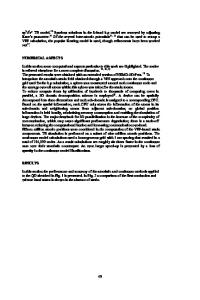Multiscale Modeling of Mechanical Response of Quantum Nanostructures
- PDF / 87,837 Bytes
- 6 Pages / 612 x 792 pts (letter) Page_size
- 86 Downloads / 362 Views
U9.2.1
Multiscale Modeling of Mechanical Response of Quantum Nanostructures Vinod K. Tewary and Bo Yang Materials Reliability Division National Institute of Standards and Technology Boulder, Colorado, USA ABSTRACT A multiscale Green’s function method is described for modeling the mechanical response of quantum nanostructures in semiconductors. The method accounts for the discreteness of the lattice in and around the nanostructure, and uses the continuum Green’s function to model extended defects such as free surfaces in the host solid. The method is applied to calculate the displacement field due to a Ge quantum dot in a semi-infinite Si lattice. Corresponding continuum values of the displacement field are also reported. INTRODUCTION The mechanical response of nanostructures in a host solid (matrix) is sensitive to its discrete atomistic structure as well as presence of surfaces and interfaces in the matrix. The continuum model smears out the discreteness and is inadequate to describe the response of the solid inside or close to the nanostructure. It is necessary to model the discrete atomistic structure of the lattice in this region. On the other hand the continuum theory is valid at sufficiently large distances from the nanostructures and is also adequate to model free surfaces and interfaces that are not too close to the nanostructures. At the macroscopic level the continuum theory has been very successful for interpreting measurements of stresses and strains that are essentially the continuum model parameters. The problem is that the physical processes that determine the macroscopic stresses and strains occur at the atomistic or sub-nano scales. Hence a multiscale model is needed to relate the physical processes to macroscopic parameters for the purpose of design and interpretation of experiments. We describe a multiscale Green’s function method for modeling the mechanical response of nanostructures such as quantum dots (QDs) in semiconductors. The model accounts for the discrete atomistic structure in the nanostructure and, in the same formalism, treats the free surface of the matrix as a continuum. This is justified unless the nanostructure is too close to the surface. Our theory relates the discrete lattice distortion at the atomistic scale in the nanostructure to measurable parameters of the continuum model and bridges the crucial length scales for modeling nanostructures. Our method is based upon the fact that the lattice Green’s function for a perfect solid reduces to the continuum Green’s function asymptotically [1]. The Green’s function for a solid containing defects does not reduce to the continuum Green’s function. We write the response of a solid containing a nanostructure in terms of the perfect lattice Green’s function of the matrix and Kanzaki forces [1]. The Kanzaki forces account for the discrete atomistic nature of the nanostructure and are calculated by using the defect Publication of the National Institute of Standards & Technology, an agency of the US Govt.; not subject to copyright.
Downlo
Data Loading...










